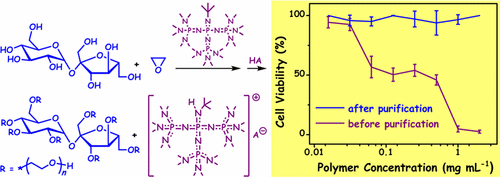当前位置:
X-MOL 学术
›
Biomacromolecules
›
论文详情
Our official English website, www.x-mol.net, welcomes your
feedback! (Note: you will need to create a separate account there.)
Revealing the Cytotoxicity of Residues of Phosphazene Catalysts Used for the Synthesis of Poly(ethylene oxide)
Biomacromolecules ( IF 5.5 ) Pub Date : 2017-09-01 00:00:00 , DOI: 10.1021/acs.biomac.7b00891 Yening Xia 1 , Jizhou Shen 2 , Haleema Alamri 3 , Nikos Hadjichristidis 3 , Junpeng Zhao 1 , Yucai Wang 2 , Guangzhao Zhang 1
Biomacromolecules ( IF 5.5 ) Pub Date : 2017-09-01 00:00:00 , DOI: 10.1021/acs.biomac.7b00891 Yening Xia 1 , Jizhou Shen 2 , Haleema Alamri 3 , Nikos Hadjichristidis 3 , Junpeng Zhao 1 , Yucai Wang 2 , Guangzhao Zhang 1
Affiliation

|
We herein report a case study on the toxicity of residual catalyst in metal-free polymer. Eight-arm star-like poly(ethylene oxide)s were successfully synthesized via phosphazene-catalyzed ring-opening polymerization of ethylene oxide using sucrose as an octahydroxy initiator. The products were subjected to MTT assay using human cancer cell lines (MDA-MB-231 and A2780). Comparison between the crude and purified products clearly revealed that the residual phosphazenium salts were considerably cytotoxic, regardless of the anionic species, and that the cytotoxicity of more bulky t-BuP4 salt was higher than that of t-BuP2 salt. Such results have therefore put forward the necessity for removal of the catalyst residues from PEO-based polymers synthesized through phosphazene catalysis for biorelated applications and for the development of less or nontoxic organocatalysts for such polymers.
中文翻译:

揭示用于合成聚环氧乙烷的磷腈催化剂残留物的细胞毒性
我们在此报告了一项有关无金属聚合物中残留催化剂毒性的案例研究。以蔗糖为八羟基引发剂,通过磷腈催化环氧乙烷的开环聚合反应,成功合成了八臂星形聚环氧乙烷。使用人癌细胞系(MDA-MB-231和A2780)对产品进行MTT分析。粗产物和纯化产物之间的比较清楚地表明,无论阴离子种类如何,残留的磷氮烯鎓盐都具有相当大的细胞毒性,并且更大体积的t- BuP 4盐的细胞毒性高于t- BuP 2的细胞毒性。盐。因此,这样的结果提出了从用于生物相关应用的磷腈催化合成的PEO基聚合物中除去催化剂残留物以及开发用于这种聚合物的较少或无毒的有机催化剂的必要性。
更新日期:2017-09-04
中文翻译:

揭示用于合成聚环氧乙烷的磷腈催化剂残留物的细胞毒性
我们在此报告了一项有关无金属聚合物中残留催化剂毒性的案例研究。以蔗糖为八羟基引发剂,通过磷腈催化环氧乙烷的开环聚合反应,成功合成了八臂星形聚环氧乙烷。使用人癌细胞系(MDA-MB-231和A2780)对产品进行MTT分析。粗产物和纯化产物之间的比较清楚地表明,无论阴离子种类如何,残留的磷氮烯鎓盐都具有相当大的细胞毒性,并且更大体积的t- BuP 4盐的细胞毒性高于t- BuP 2的细胞毒性。盐。因此,这样的结果提出了从用于生物相关应用的磷腈催化合成的PEO基聚合物中除去催化剂残留物以及开发用于这种聚合物的较少或无毒的有机催化剂的必要性。











































 京公网安备 11010802027423号
京公网安备 11010802027423号